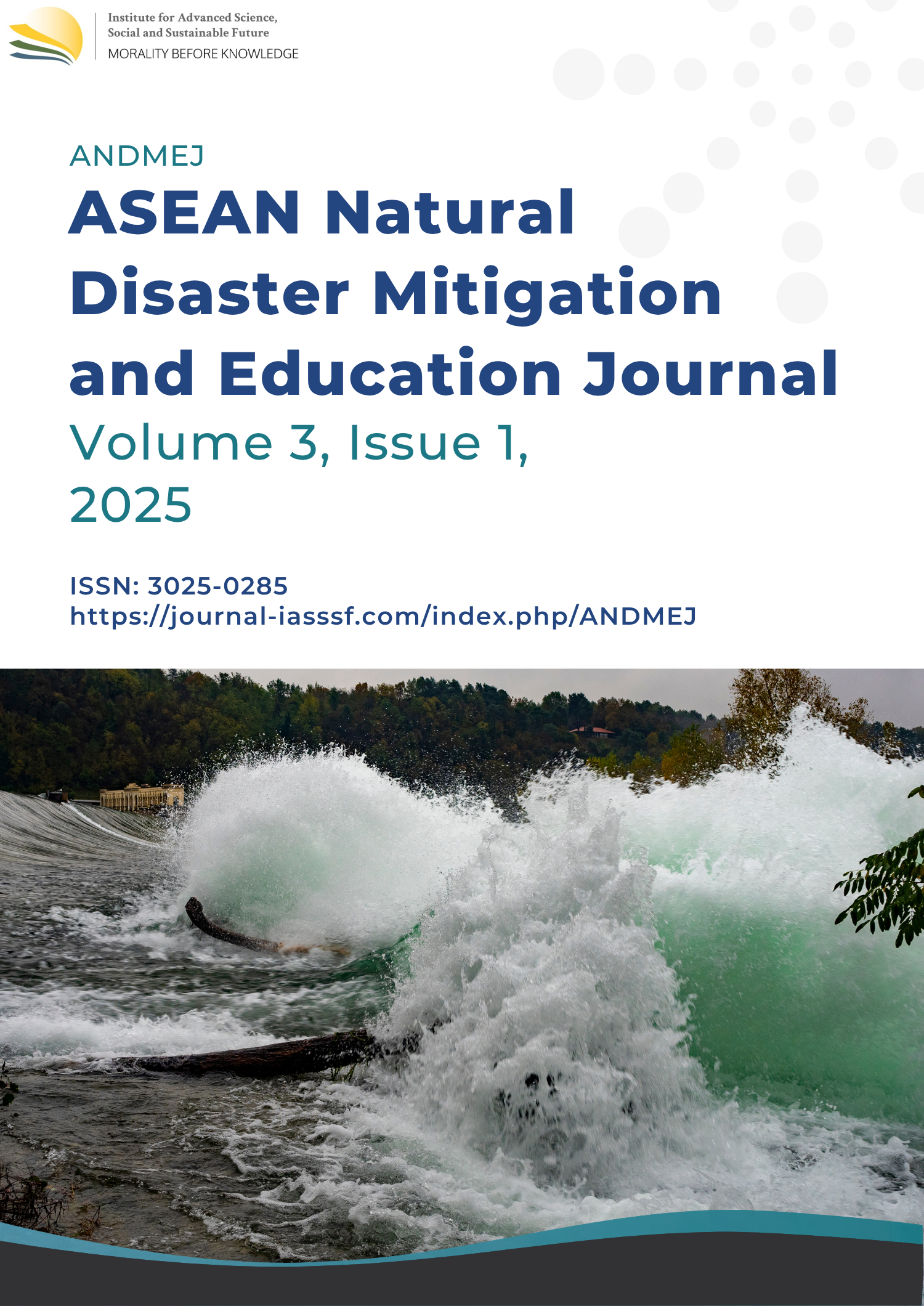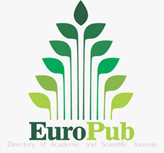Digital innovation and social adaptation in urban flood risk reduction: A study on community-based coping strategies
DOI:
https://doi.org/10.61511/andmej.v3i1.2025.1829Keywords:
flood, coping strategies, community collaboration, urban, technologyAbstract
Background: Flooding in the capital city of DKI Jakarta is still a serious problem that has a broad impact on society. Rapid urbanization, suboptimal drainage systems, and climate change contribute to the increasing frequency and impact of flooding. Flooding not only causes economic losses, but also impacts on health, loss of livelihoods, agriculture and livestock sectors, disruption to education, and damage to public and private infrastructure, effective strategies are needed to increase community resilience in the face of these disasters. Methods: This study used a methodological approach related to coping strategies in the face of flooding. The theory of coping strategies developed by Lazarus & Folkman (1984) is used as the basis of analysis to understand how communities can adapt and respond to floods. In addition, a study of digital platforms such as petabencana.id was conducted to see the role of technology in improving community preparedness. Findings: The results show that communities use various copingstrategies in dealing with floods, both those that focus on problem-focused coping and those that focus on emotion-focused coping. Technology-based approaches, such as the use of petabencana.id, allow communities to share information in real-time, improve coordination in emergency response, and speed up decision-making in disaster situations. This research also highlights the importance of a combination of proactive and reactive coping strategies in dealing with floods. In addition, utilizing digital technology in disaster mitigation can increase the effectiveness of emergency response efforts and strengthen community engagement. Conclusion: This study confirms that the application of appropriate coping strategies, supported by technology and multi-stakeholder collaboration, can help communities deal more effectively with the impacts of flooding. Novelty/Originality of this article: Increasing education on coping strategies, optimizing the use of information technology, and strengthening social networks are important steps in flood mitigation and management in Jakarta.
References
Alharbi, K., & Haq, M. A. (2024). Enhancing disaster response and public safety with advanced social media analytics and natural language processing. Engineering, Technology & Applied Science Research, 14(2), 1–8. https://doi.org/10.48084/etasr.7232
Bappenas. (2021, August). Policy paper: Community-based flood risk management in urban areas to build systemic resilience. National Development Planning Agency. https://www.undp.org/indonesia/publications/community-based-flood-risk-management-urban-areas-build-systemic-resilience
Charisna, N., Hamidah, & Adib, M. (2018). Coping strategies for the flood disaster practiced by the Pekauman community in Sidoarjo Regency. International Conference Postgraduate School, 834–838. https://doi.org/10.5220/0007552408340838
Folkman, S., Lazarus, R. S., Dunkel-Schetter, C., DeLongis, A., & Gruen, R. J. (1986). Dynamics of a stressful encounter: Cognitive appraisal, coping, and encounter outcomes. Journal of Personality and Social Psychology, 50(5), 992–1003. https://doi.org/10.1037//0022-3514.50.5.992
Forrest, S. A. (2024). Governing flood risk management: towards flood resilience. In Handbook on the Governance and Politics of Water Resources (pp. 116-127). Edward Elgar Publishing. https://doi.org/10.4337/9781800887909.00017
Gelgel, N. M. R. A., Pramudita, M. A., & Silalahi, J. E. (2023). Penggunaan media sosial Instagram dalam komunikasi bencana kesiapsiagaan erupsi Gunung Merapi. COMMENTATE: Journal of Communication Management, 4(2), 151–165. https://doi.org/10.37535/103004220235
Hadi, M. Z. S., Kristalina, P., Pratiarso, A., Fauzan, M. H., & Nababan, R. (2024). Intelligent system detection of dead victims at natural disaster areas using deep learning. Journal of Disaster Research, 19(1), 204–213. https://doi.org/10.20965/jdr.2024.p0204
Harahap, H. S. (2024). Penggunaan media sosial untuk penyebarluasan informasi peringatan dini banjir ke masyarakat (Studi kasus: BPBD Provinsi DKI Jakarta). Jurnal Syntax Admiration, 5(11), 4592–4603. https://doi.org/10.46799/jsa.v5i11
Hong, X., Da, L., & Wei, H. (2025). FM-LC: A hierarchical framework for urban flood mapping by land cover identification models. arXiv preprint arXiv:2507.19818. https://doi.org/10.48550/arXiv.2507.19818
Jia, W., Liang, B., Lu, Y., Khan, M. A., & Zheng, L. (2025, June). A comprehensive survey on deep learning solutions for 3d flood mapping. In Pacific-Asia Conference on Knowledge Discovery and Data Mining (pp. 21-38). Singapore: Springer Nature Singapore. https://doi.org/10.1007/978-981-96-8295-9_2
Lam, N. S. N., Meyer, M., Reams, M., Yang, S., Lee, K., Zou, L., Mihunov, V., Wang, K., Kirby, R., & Cai, H. (2023). Improving social media use for disaster resilience: Challenges and strategies. International Journal of Digital Earth, 16(1), 3023–3044. https://doi.org/10.1080/17538947.2023.2239768
Lazarus, R. S., & Folkman, S. (1984). Stress, appraisal, and coping. Springer Publishing Company.
Liu, N., & Zhang, F. (2025). Urban green spaces and flood disaster management: Toward sustainable urban design. Frontiers in Public Health, 13, 1583978. https://doi.org/10.3389/fpubh.2025.1583978
Manandhar, B., Cui, S., Wang, L., & Shrestha, S. (2023). Urban flood hazard assessment and management practices in South Asia: A review. Land, 12(3), 627. https://doi.org/10.3390/land1203062
Maryam, S. (2017). Strategi coping: Teori dan sumberdayanya. Jurnal Konseling Andi Matappa, 1(2), 101–107. https://journal.matappa.ac.id/index.php/jurkam/article/view/12
Mitrousi, S., Stravoulea, T., Travlos, A., Koukia, E., & Zyga, S. (2013). Theoretical approaches to coping. International Journal of Caring Sciences, 6(2), 131–137. https://www.internationaljournalofcaringsciences.org/Issue.aspx?issueID=24&pageIndex=0&pageReason=0
Pandit, B. A. (2024). A concentrated analysis of the situation of flood control management: A review. International Journal for Science Technology and Engineering, 12(10), 133–137. https://www.ijraset.com/research-paper/concentrated-analysis-of-the-situation-of-flood-control-management
Peiris, V. T. O., & Osada, M. T. (2024). Assessment of urban resilience to floods: A spatial planning framework for cities. Sustainability, 16(20), 9117. https://doi.org/10.3390/su16209117
Petabencana.id. (2017). Jakarta flood map, February 2017. Mapbox. https://blog.mapbox.com
Petabencana.id. (2020, January 28). PetaBencana.id collaborates with NASA, BNPB, government agencies, and citizens in response to flood 2020. https://info.petabencana.id/2020/01/28/petabencana-id-berkolaborasi-dengan-nasa-bnpb-government-agencies-and-citizens-in-flood-response-2020/
Petabencana.id. (2025). The PetaBencana.id reporting feature; social media interface. https://petabencana.id
Petabencana.id. (n.d.). Petabencana.id: Community-based flood monitoring platform. https://petabencana.id/
PUB Singapore. (2022, January). Innovation in water Singapore: Closing the loops toward more sustainable water (Vol. 12). Public Utilities Board Singapore. https://www.pub.gov.sg/
Pusdatinkom BNPB. (2025, April 11). Data Informasi Bencana Indonesia (DIBI). Pusat Data, Statistik, dan Informasi Komunikasi Badan Nasional Penanggulangan Bencana. https://dibi.bnpb.go.id/
Putri, S. A. E. (2021, September 27). Smart environment: How the DKI Jakarta provincial government mitigates flooding in Jakarta. Smartcity Jakarta. https://smartcity.jakarta.go.id/id/blog/cara-pemprov-dki-do-mitigation-flooding-in-jakarta/
Rakha, A., Jabbar, A., Rasheed, H., Tul-Muntaha, S., Munir, A., Fatima, A., ... & Aadil, R. M. (2024). Nutrition crisis management after floods: A multisectoral perspective. International Journal of Disaster Risk Reduction, 116, 105141. https://doi.org/10.1016/j.ijdrr.2024.105141
Stanisławski, K. (2019). The coping circumplex model: An integrative model of the structure of coping with stress. Frontiers in Psychology, 10, 694. https://doi.org/10.3389/fpsyg.2019.00694
The World Bank. (2011). Cities and floods: Integrated management guidance for flood risk in 21st century cities and summary for policymakers. The World Bank. https://doi.org/10.1596/978-0-8213-8866-2
The World Bank. (2016, August). The role of green infrastructure solutions in urban flood risk management (Knowledge notes). Urban Flood Community of Practice (UFCOP). https://openknowledge.worldbank.org/entities/publication/fe3c417d-0afe-5c52-8015-ba966d4a8475
The World Bank. (2021). Indonesia Vision 2045 toward water security (Vol. 1). International Bank for Reconstruction and Development/The World Bank. https://indonesiawaterportal.com/library/indonesia-vision-2045-toward-water-security/
Vanelli, F., Lavagna, M., & Minifie, P. (2024, October). Flood management in the built environment: The micro-scale contribution to a distributed strategy. IOP Conference Series: Earth and Environmental Science, 1402(1), 012012. https://doi.org/10.1088/1755-1315/1402/1/012012
Vun, J., Watson, J. K., & Alyono, K. S. (2019, September 17). Urban flood resilience in Indonesia: New approaches through an urban design lens. World Bank Blogs: East Asia & Pacific on the Rise. https://blogs.worldbank.org/eastasiapacific/urban-flood-resilience-indonesia-new-approaches-through-urban-design-lens
World Population Review. (2024). Jakarta, Indonesia population 2024. https://worldpopulationreview.com/cities/indonesia/jakarta
Wu, S. (2025). Enhancing cities’ resilience to floods through urban planning and policy measures: Case studies of Zhengzhou and Mumbai. In Proceedings ICDEBA 2024. Atlantis Press. https://doi.org/10.2991/978-94-6463-652-9_5
Downloads
Published
How to Cite
Issue
Section
Citation Check
License
Copyright (c) 2025 Sapta Dwi Putri

This work is licensed under a Creative Commons Attribution 4.0 International License.

















